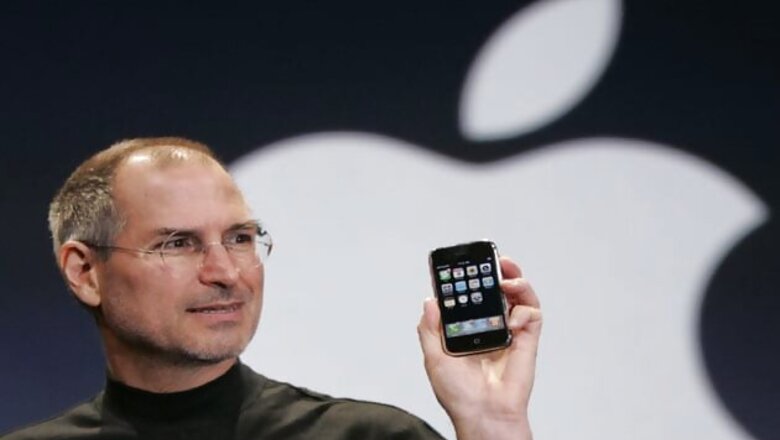
views
San Francisco: The beauty of Apple products secured Steve Jobs a place in history long before his death, but design professionals said the depth of his influence on their profession goes much deeper than the minimalist look of an iPhone. The Mac and the iPod, the iPhone and the iPad, born out of his vision of marrying high technology with an elegant and simple form, are already recogniszed as iconic products of the digital age.
One architect compared Jobs to Mies van der Rohe, the Modern designer who said "less is more" and unleashed stark glass skyscrapers on a world used to brick and mortar. "He is the virtual Mies. The Mies of the virtual world," said Harvard Graduate School of Design's Florian Idenburg. But he said that the influence of Jobs on Harvard design students went beyond the look of his products. In fact, although every person in the building appeared to have an iPhone, some aesthetes are turning against the ultra-smooth look. The enduring influence of Jobs may be more in how his products unlock creativity and change how we view the world - and what we want and make the world to be.
Idenburg said students who constantly use the iPhone in their work want their own designs to have a similar "flexibility and looseness," so that a concert hall could be ready to host different types of events, for instance. "It's a nice little phone. But what it really does, is it absolutely changes how people behave," said Thom Mayne, the avant garde Los Angeles architect who is a winner of architecture's Nobel prize, the Pritzker.
"We're all interested in what buildings look like, but what I'm interested in is how they reshape behavior," he said. "He's a symbol that we really need in this culture at this time."
Big and small
Jobs maintained strict control over the creation of his own product, even as he expected others to invent new uses for it. He displayed an inspiring combination of mastering detail and dreaming big, said British architect Norman Foster, known for working on major projects such as the Millennium Bridge and Swiss Re's headquarters dubbed "The Gherkin" in London. "Steve Jobs encouraged us to develop new ways of looking at design to reflect his unique ability to weave backwards and forwards between grand strategy and the minutiae of the tiniest of internal fittings," said Foster.
Foster, who has designed a new Apple headquarters that looks like a cross between a donut and a spaceship, called Jobs "One of the truly great designers and mentors". All over the world, iPods are tucked into the back of torn jeans and in the pockets of executive suits, strapped to the arms of joggers or entertaining commuters on tedious journeys home, and the lesson for many designers is that daily objects can be beautiful.
t Paris Fashion Week, which ended on Wednesday, fashion buyers took photos of dresses with their iPad and once the show was over, they flicked through them as a catalog they had just created and decided which ones they wanted to buy. "What I think was extraordinary about Steve Jobs was his ability to create sophisticated objects that are simple to use. My three-year-old daughter Giulia knows how to use the iPhone," said Paolo Pininfarina, CEO of the eponymous group that has designed Ferrari sportscars since the early 1950s.
Museums around the world have been collecting early Apple and Jobs products, starting from the original Apple 1 developed in a bedroom in the 1970s by Jobs and Apple co-founder Steve Wozniak to the first NeXt computer, a magnesium "cube" developed by Jobs during a break with Apple in the 1980s. "It (the iPod) may not be working in 20 years time but it will remain in that echelon of great designs for sure," said Campbell Bickerstaff, curator for the information and communication technology collections at Sydney's Powerhouse Museum, which collects icons of contemporary culture,
From calligraphy to the apple mac
Jobs was inspired by design early on, having revealed in a famous 2005 commencement speech to Stanford University students - which is easy to view on YouTube - that one of his formative experiences was a calligraphy class at Reed College. "None of this had even a hope of any practical application in my life. But 10 years later, when we were designing the first Macintosh computer, it all came back to me. And we designed it all into the Mac. It was the first computer with beautiful typography," Jobs said at the time.
"I was almost brought to tears" watching a video of the address, said Calvin Klein, the fashion designer, who attributed part of Jobs's success to his devotion. "It sounds like he had a full life. But to build a business of that size, and to be constantly innovating, it takes up as much as one can imagine. It becomes your life. It requires a dedication that is very special and very unusual."
In the Stanford address, Jobs also spoke of the importance of being confident in oneself, a command that resonates with artists and designers. "Steve Jobs has shown that breakthrough products come from taking intuitive risks, not from listening to focus groups," said British industrial designer James Dyson, whose bagless vacuum cleaner that swivels on a ball is an object of desire as well.




















Comments
0 comment